Well guys, I think I found my Grail. Decades ago, nerdy little art history major me wandered down a side path that led to antique jewelry, and there I proceeded to fall in love with both the designs and the quest for ancient knowledge that fueled the mid-19th century archaeological revival. And what do we have here? It’s the Alma-Tadema Armlet, the actual armlet commissioned by Victorian painter Sir Lawrence Alma-Tadema as a gift for his wife, Laura — who he later depicted wearing the armlet in two of his best-known paintings. (It’s also shown discarded in the background of a third.)
I need it like air.
The golden armlet — which is designed to wrap four times around the arm — takes the form of a double-headed engraved snake, with each snake head flanked by stylized horses’ heads. The snakes have diamond eyes, while the horse’s eyes are alternately set with turquoise, ruby, sapphire and emerald.
It’s being sold by the London antique jewelry firm Wartski, and in their write-up of the piece, they touch on Sir Lawrence’s longtime focus on classical themes in his paintings. He initially centered on Greek and Egyptian motifs, but he began to add super decadent Roman Empire themes to his work following two trips to Italy in the 1860s, where he was inspired and fascinated by the excavations being carried out at Pompeii and other sites. This armlet directly shows that inspiration, as Wartski calls attention to this similar 4th century BC armlet, unearthed in a tomb at the Greek settlement of Roccagloriosa, Italy. (The piece still resides in the Museo Civico Archeologico of Roccagloriosa; I don’t think they have a website, so my thanks to the person who helpfully posted a photo of it on TripAdvisor.)
Sir Lawrence was just one of many people inspired by the excavations, and archaeological revival pieces were all the rage in Victorian London as various jewelers — led by the Castellani family, who I’ve covered before — created their own versions of the ancient designs. So it’s interesting that, instead of choosing one of the jewelers known for the archaeological style, Sir Lawrence chose to give this commission to J.S. and A.B. Wyon, a firm of metal engravers. (Pretty good metal engravers, though, since they were the “chief engravers of Her Majesty’s Seals.”) And he did want the piece inscribed: he had his wife’s name, Laura Theresa Alma Tadema, engraved in Greek script along the outside of the armlet, as well as scaling added to the body of the snake.
Now, on to the paintings!
The armlet first appeared in Sir Lawrence’s The Sculpture Gallery from 1874. The painting depicts a group of people viewing artwork in an ancient gallery or studio, and the observers are actually members of the artist’s own family. Laura, wearing the armlet, stands at the back of the room alongside the artist’s two small daughters. (The girls were from a previous marriage; Sir Lawrence was widowed before he married Laura.) The artist himself — in a wonderful gesture familiar to parents everywhere — sits in front of them to the left, gently extending his arm to keep the enthralled girls from getting too close to the display. Laura’s sister and brother complete the group in the foreground.
Many of the artworks shown in the painting are also based on real, recognizable pieces from such places as the Vatican Museums and the Capitoline Museum in Rome.
The armlet also appears in 1888’s famous The Roses of Heliogabulus, which depicts the story of Heliogabalus, a decadent Emperor of Rome who smothered his guests by upending a canopy full of rose petals during a banquet. You can see Laura on the left, wearing the armlet as she’s overwhelmed by petals.
Wartski says the story (which came from the Historia Augusta and was probably made up), originally identified the petals as a mix of various flowers, but Sir Lawrence switched it to roses. Because he couldn’t get them off-season in London, “he is reputed to have had rose petals sent from the South of France each week during the four months it took to paint it.”
I don’t have space for a photo, but the armlet also appears in the background of The Frigidarium from 1890. Laura again features in the painting, but this time the armlet is sitting on a shelf behind her.
So of course Wartski doesn’t provide a price for the armlet, because such information isn’t for the likes of us gawping povvos. They showed the piece recently at a couple of posh art fairs, and their director Kieran McCarthy said they were hoping it would be bought by Spanish billionaire Juan Antonio Pérez Simón, the man who owns The Roses of Heliogabulus, “so someone could wear it sitting in front of the painting.”
This ring features a 3rd century AD Roman agate with unusual opaque and transparent striations of color that the engraver used to inspire his composition. Taking advantage of the largely transparent lower half of the stone, he incised the figure of a man fishing, with half of his body appearing to wade through water. The dealer, London’s Rowan and Rowan, have identified the man as the Roman god Mercury due to his petasos, or wide-brimmed hat.
The gold setting is of a later date and the ring itself is sold, sadly, but I’m grateful that they’ve kept the piece online so we can marvel at it. It’s a wonderful thing and I’ve never seen anything like it.
The silver-capped object above is called a lodestone — a special type of a naturally magnetized mineral called magnetite that exhibits north-south polarity. Though it’s been used and studied for centuries, scientists still aren’t totally sure why lodestone is so different from regular magnetite, but the theory is that it was struck by lightning, which created such a strong magnetic field that it permanently magnetized the mineral.
The use of lodestones goes back as far as the 4th century BC — when the Chinese used them to try to predict the future — and over the centuries they were discovered to be valuable navigational aids. Because they don’t lose their magnetism, lodestones were brought along on voyages to re-magnetize iron compass needles, which gradually lost their strength and usefulness over time. This process was called “refreshing the needle,” and it was practiced up until around 1760, when a permanently magnetic needle was created.
Lodestones also were believed to have healing properties, and this one (technically it’s a 1929 copy of the circa 1702-1714 original) was supposedly used by England’s Queen Anne to heal her subjects. The piece is in the always fascinating Sir Henry Wellcome's Museum Collection in London’s Science Museum, and here’s their explanation:
Anne objected to touching her subjects directly and instead used the stone. It was believed that the monarch’s power could heal tuberculosis of the skin known as the ‘King’s Evil’ or scrofula. The monarch’s power could be transferred to objects such as lodestones or touchpieces. The lodestone was reputedly given to John Rooper, one of Queen Anne's staff (deputy Cofferer), and was passed down three generations of his family before being sold at auction. The silver casing was added later to protect the family heirloom.
Scrofula! Now there’s an illness you don’t hear much about these days. Yay antibiotics.
Anyway, the lodestone that prompted this whole entry dates to around 1700 and is capped at top and bottom with scalloped silver. It’s included in the Bonhams London online Instruments of Science and Technology auction ending tomorrow, and it carries an estimate of £500 - £800, or US $650 - US $1,000.
Totally unrelated but I WILL SURELY PERISH if I don’t pass along this discovery: While rooting through the Wellcome Collection in search of lodestones, I stumbled across this highly decorated ca. 1601-1700 Spanish earthenware jug that depicts two men, with one of them…um, bending over, and the inscription: “I am Don Joaquin Hernandez's jar. Through intense devotion to my constitution I find myself on this occasion shamefully syringed at the hands of a serf.”
This absolutely gorgeous French antique cigarette case and match safe set is made of carved agate with applied Wedgwood plaques and further embellishments of rose-cut diamonds and blue enamel. The lot notes also mention that it’s “accompanied by a fitted Cartier pouch,” so that’s an intriguing yet noncommittal bit of info. The piece is included in tomorrow’s Freeman’s | Hindman Important Jewelry live auction in Chicago, and it’s estimated at $2,000 - $3,000.
Circa 1900, this finely-woven bicolored mesh purse features a playing-card motif, with applied charms of amethyst, garnet, or chrysoberyl surrounded by rose-cut diamonds. The bag’s frame is set with trefoils of circular-cut rubies and sapphires interspersed with brilliant-cut diamonds. It’s in the Bonhams London Knightsbridge Jewels auction on September 18th and is estimated at £8,000 - £12,000 (US$10,000 - US$16,000).
LOOK at that opal.
I feature more Tiffany here than I really would prefer, but damned if they aren’t always showing up with spectacular pieces. This circa 1910s opal, diamond, and enamel necklace is by Louis Comfort Tiffany for Tiffany & Co., and features a large pear-shaped opal and a smaller oval opal set in a foliate-motif frame of yellow gold, with lovely gradations of colored enamel that blend with the colors of the stones.
The piece is included in the Rago and Toomey & Co. Jewelry: Antique to Art Deco auction on September 17th in Chicago, and it’s estimated at $15,000–20,000.
It’s another example of Tiffany and Co.’s long history — led by their chief gemologist George Frederick Kunz (1856–1932) — of sourcing exceptional gemstones for their creations.
In honor of the glorious and much-yearned-for approach of autumn, here is a limited edition 2023 yellow and black monogram leather pumpkin bag by Yayoi Kusama for Louis Vuitton. It’s in the Christie’s New York Handbags Online: The September Edition online sale closing on September 18, and it’s estimated at $10,000 - $15,000. This is a familiar and favorite subject for Kusama, who has said “Pumpkins have been a great comfort to me since my childhood. They speak to me of the joy of living. They are humble and amusing at the same time, and I have and always will celebrate them in my art.”
It’s a fun piece, but the whole high-end bag thing baffles me. There’s a 2023 crocodile Kelly bag in that sale that already has a bid of $100,000. Christ on a bike.
Ok, time to bring this to a close, although there is one last thing that I decided not to picture. I’ll mention it anyway because somebody might be interested: Jackie Kennedy Onassis’s two-piece Valentino wedding dress is being offered in the online Classic Luxury Style Icons sale that’s running at Bonhams Los Angeles from September 16th through the 26th. Onassis wore the dress for her wedding to Aristotle Onassis on October 20, 1968 in Skorpios, Greece, and it’s from the “Sfilata Bianca” collection shown by Valentino in Rome in 1968. It pairs a sleeveless cream silk crepe pleated dress with a chiffon and lace overlay shell that buttons on the back, and to be honest it’s pretty blah? Of its time, I guess.
You can see a few different views of the dress (and the wedding) in this article from WWD. It’s estimated to sell for $8,000 - $12,000.
Anyway, I hope you’re all well and happy. Enjoy the rest of your week and watch out for serfs.
Love, M x




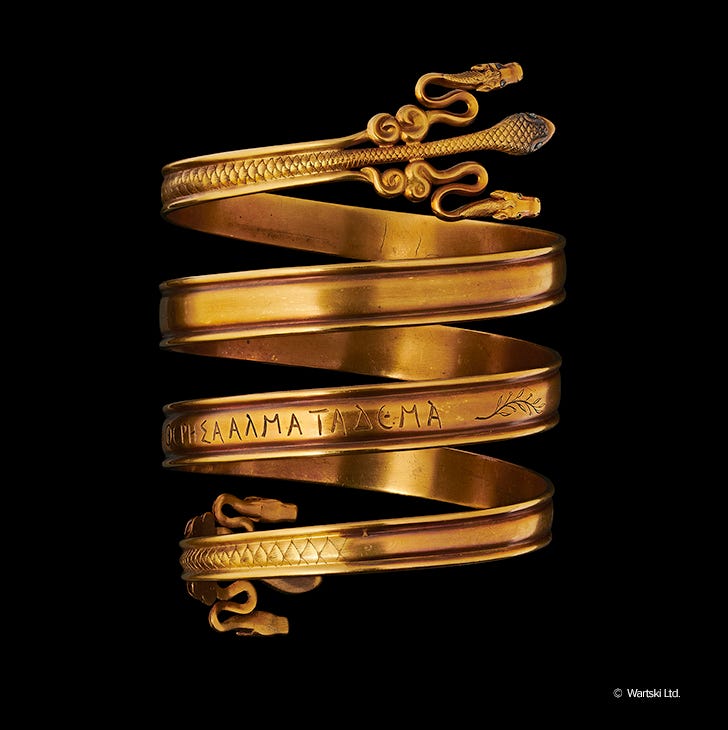
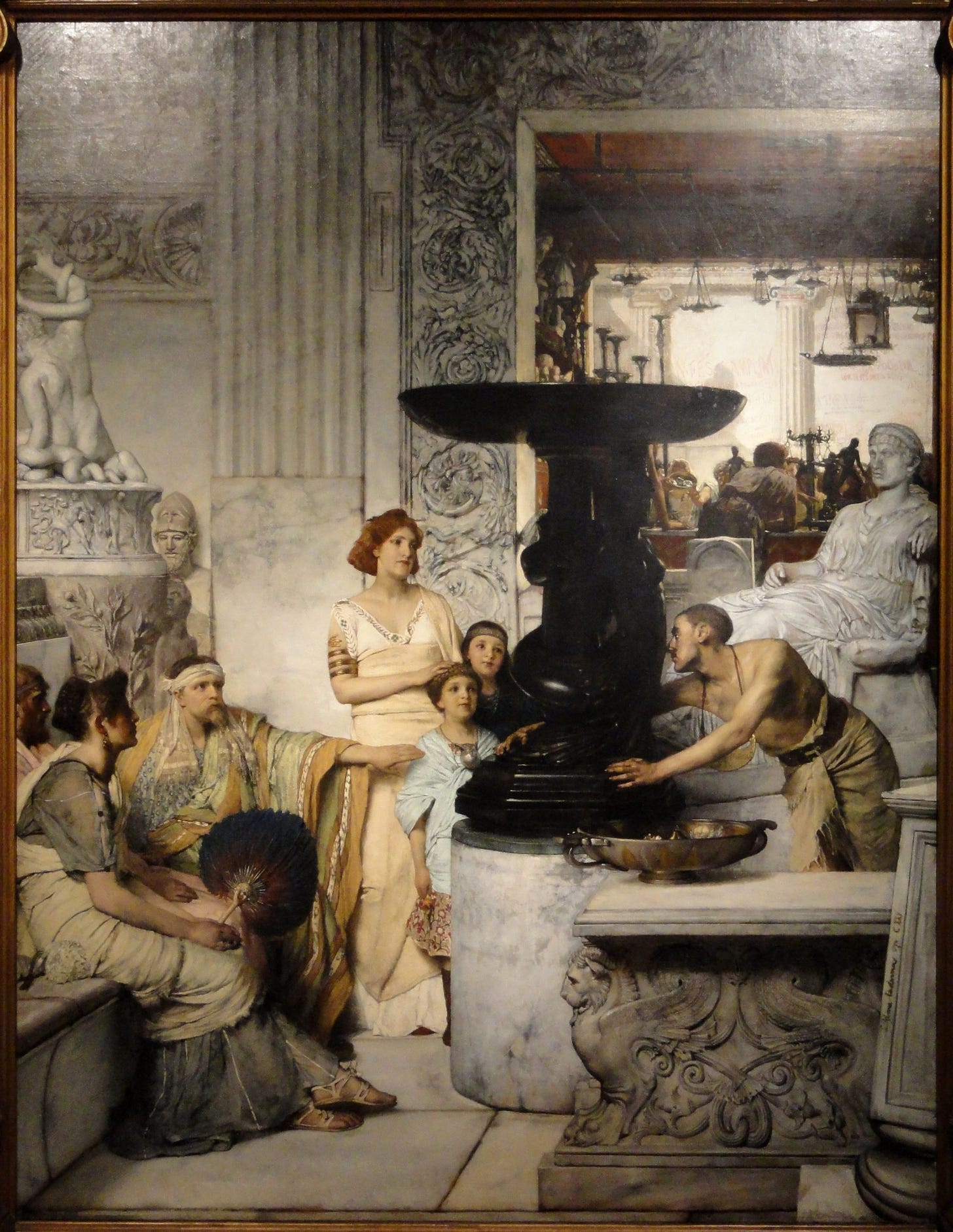
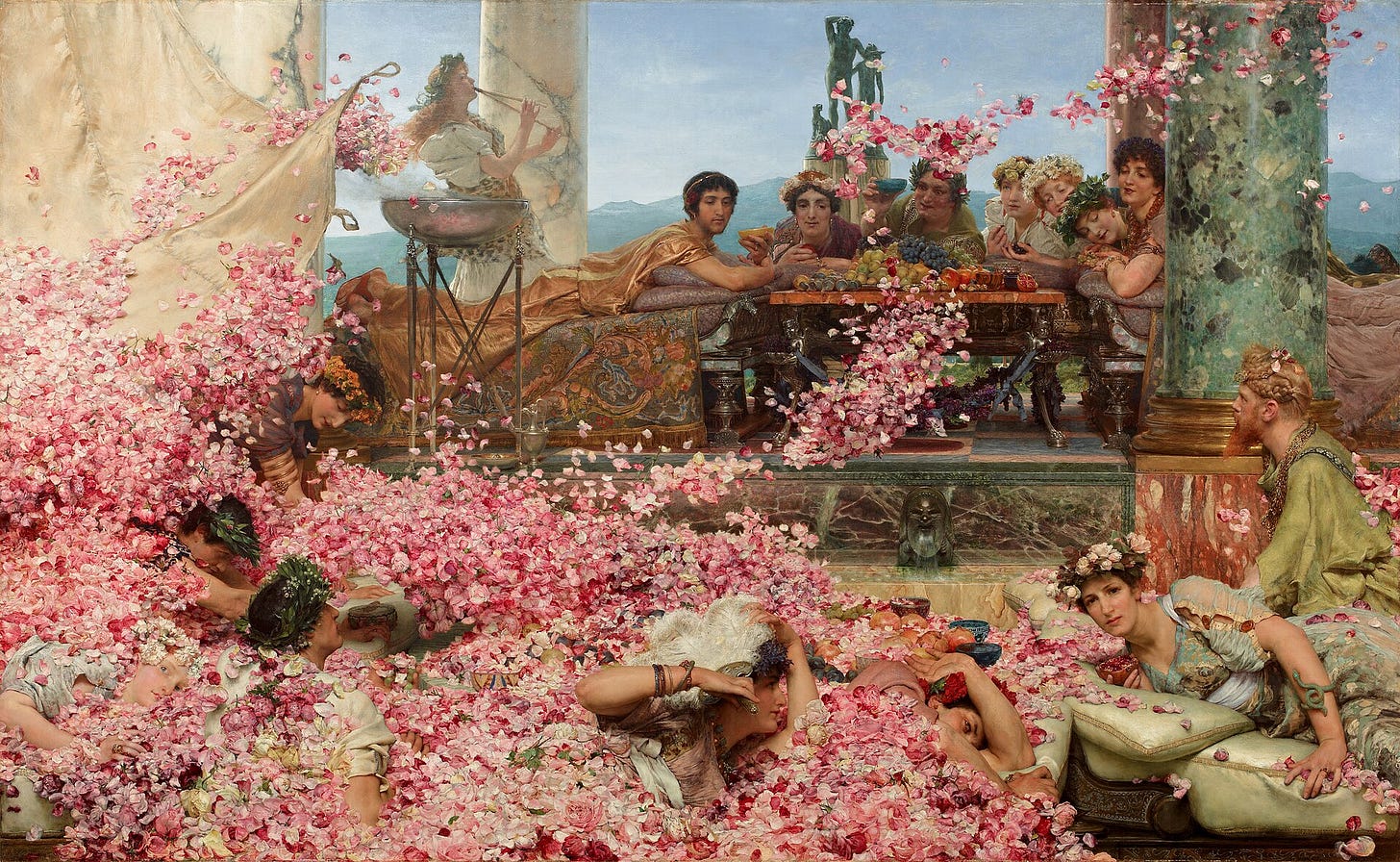
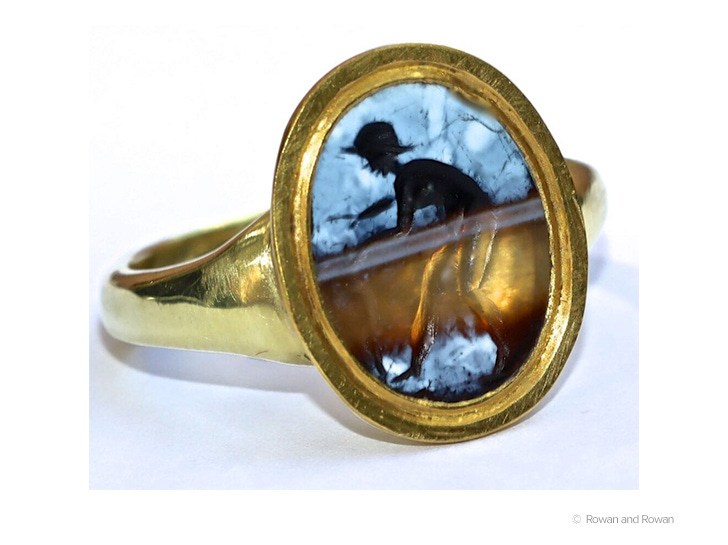
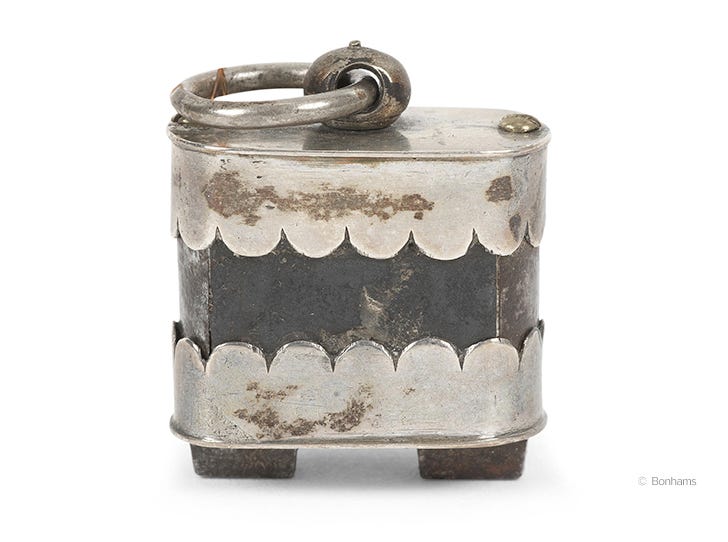
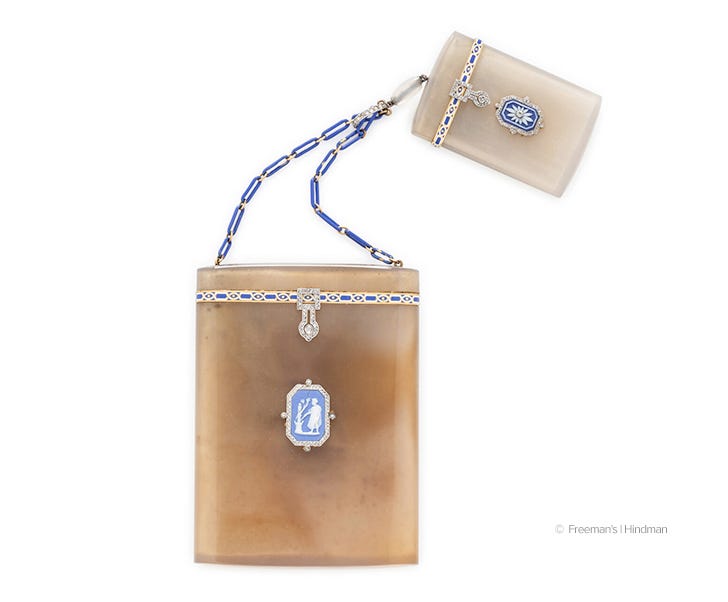
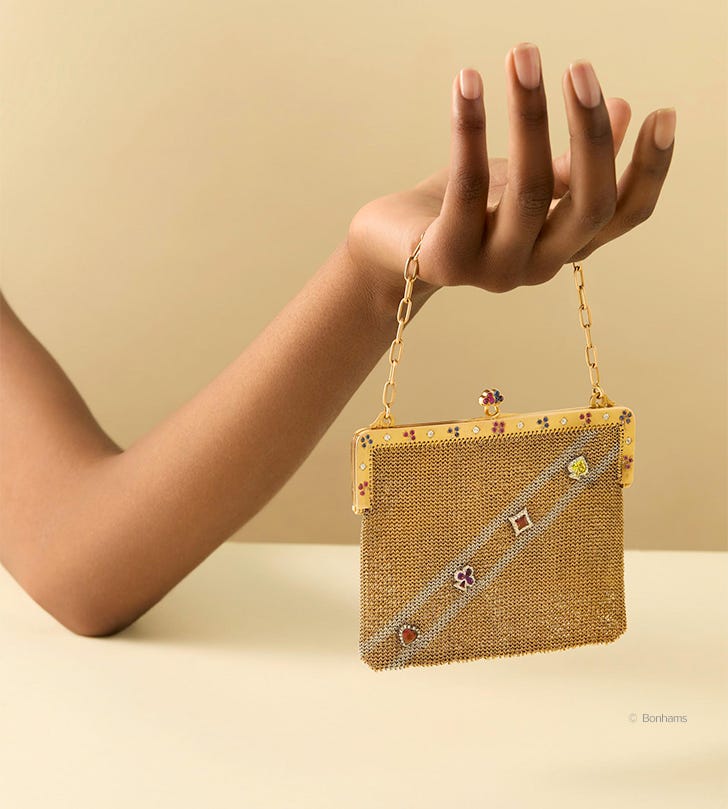

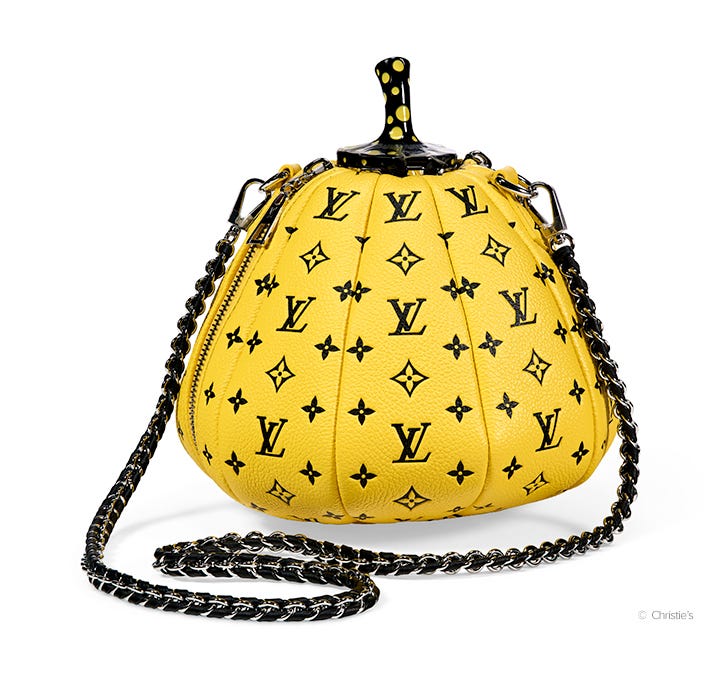
As always a very entertaining and impressively researched post. I love seeing the armlet and all the associated paintings. Also inspiring a fair bit of envy - the bicoloured mesh bag is beautiful, and the opal is just stunning. Thank you.
Monica, this is a great post – entertaining, informative, and oh so well-written!